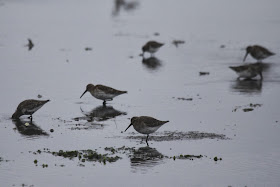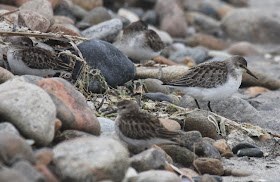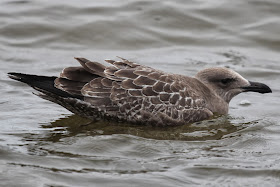White-rumped Sandpipers are Shorebirds that I enjoy watching. It is fun to search for them and to pick out of flocks of peeps like searching for banded Gulls in the large winter flocks of Gulls. You never know when they will be mixed in with the other Sandpipers and when you do find them you are rewarded with a very special and lovely little Sandpiper.
The weather forecast reported overcast skies in the early morning giving way to sunny skies by mid-morning. Even though the sun never made an appearance today, the cloudy skies and early morning cool temperatures really gave it a late summer/early fall feel which was perfect for Shorebirding...especially for taking pictures; no backlighting issues to worry about.
Low tide was at 10:30 am this morning which was perfect for the point. The falling tide exposed the small rocky reefs around the bays side of the point, and the mudflats in the lagoon. I arrived at 8:30 in the parking lot and began walking the one and a half mile walk out to the point on the bay side. Along the way a few Black-bellied Plover, Semi-palmated Plover and Sanderlings were sprinkled along the shoreline such as this Sanderling >
In the distance, the exposing reefs were attracting the large number of Oystercatchers that are common here this time of year >
About a third of the way out, this Merlin passed over the beach spit and flew towards the CT shore never veering west towards the point. >
About halfway out, I ran into a lovely couple from Rhode Island; Betty and Tom Getz. They like me were taking the day to enjoy a beautiful day birding at this wonderful location. We stopped for a moment and watched the Oystercatchers as they started to congregate on the rapidly exposing rocky reefs>
With the Oystercatchers were handfuls of Black-bellied Plovers and Sanderlings >
By now the mudflats in the lagoon were starting to become exposed but the water was still a bit too high to cross over the wash at the mouth of the inlet. The best way to get to the other side of the lagoon is to simply walk around it. Most of the lagoon's tidal shoreline was exposed except for a small stretch along the southwest side. Since I had my walking boots on, I went ahead, Betty and Tom would have about a half hour to wait before the rest of the shoreline was passable.
By now more small flocks of Shorebirds started filtering into the lagoon. By the time I walked around there were a good number of Shorebirds feeding on the mudflats. The flocks included Dunlin and Semi-palmated Sandpiper>
(from l to r): Semi-palmated Plover, Dunlin, and Semi-palmated Sandpiper>
This small group of Dunlin, Semi-palmated Plover and Sandpiper lands with a Greater Yellowlegs >
More Shorebirds arrive>
This group of sixty-five fly into the lagoon>
Dunlin, Least and Semi-palmated Sandpiper, and a single White-rumped Sandpiper (right center)>
A single Sanderling in this group>
White-rumped (right center) >
Dunlin, White-rumped (top center) Least and Semi-palmated Sandpiper >
After spending an hour with the Shorebirds in the lagoon, I decided to walk down the shore towards the point. A hen Red-breasted Merganser walked out onto the shore near the mouth of the lagoon >
Oystercatchers again on the move>
A few Ruddy Turnstones were feeding along the reef shoreline >
The Oystercatchers were spread out along the bay side shoreline >
Another Ruddy Turnstone flies in joining this Black-bellied Plover >
A little farther down the shore, the four Red Knots that were reported yesterday were feeding in the tidal pools >
One of the Knots still retained some of its "spring red" breeding plumage >
With a Black-bellied Plover>
Juvenile feeding amongst the Mussels and Periwinkles>
Adult with partial transitional plumage (above) and juvenile (below)>
"That pool was deeper than I thought it was" .......
.......but I can still touch bottom"! >

I didn't count the Oystercatchers, but there were approx. forty to fifty there this morning >
Ruddy Turnstone showing its striking open wing plumage >
I walked back to the lagoon to let Betty and Tom know that I had located the Red Knots. While I was there I decided to try for the White-rumped Sandpipers again. I had spotted them earlier, but they were on the outside of the mudflats, too far for any good images. Maybe by now they were closer to the shoreline. This Semi-palmated Sandpiper was quite tame, walking within a few feet of me >
Interesting plumage on this Least Sandpiper >
The cobble just above the high tide line held small pockets of sleeping/preening/resting Least and Semi-palmated Sandpipers >
A pair of Semi-palmated Sandpipers>
Least Sandpipers and a single Semi-palmated Sandpiper (right)>
Semi-palmated Sandpiper (left) and a pair of Least Sandpiper>
Dunlin on the flats with a single Semi-palmated Plover (left top) and a single Semi-palmated Sandpiper (top center)>
A pair of Dunlin and a Semi-palmated Sandpiper (top left)>
Semi-palmated Plover>
And finally....one of the White-rumped Sandpipers moved closer >
Eventually, one of the White-rumped Sandpipers walked right up to me.....(in some instances too close for my camera). This one caught a small bloodworm>
Probing >
Listening>
Probing some more! >
This is a good image to demonstrate one of this birds field ID marks: its longer primary extension. This species has two primaries that extend beyond the tip of the tail where all the other peeps (with the exception of Baird's) show the tips of primaries the same length as the tip of the tail.>
Quite a wide bird for such a long and slender profile >
More study views of this impressive Sandpiper>
A few Cormorants joined the Shorebirds on the flats by walking out of the water and resting on the beach >
Since the White-rumped Sandpipers offered me a better look at them, I decided to head out around the point. I spotted these adult Brant as they swam up the shore.>
The Oystercatchers continued all the way to the point>
Also I was surprised to see a spattering of American Pipits on the beach>
If there are old pilings, you have to have Cormorants! >
A distant Cormorant flies by a small flock of Common Eider>
There were three flocks of Cormorants that had gathered following a school of fish, maybe Herring or Sandeels.>
A few more Eiders>
As I walked over the boulders at the point (where the path used to be) I must have startled a Peregrine Falcon that had been roosting on a branch on the bluff near the Bank Swallow burrows. I had never seen the bird until it took off (and startled me). I wish I had spotted the Falcon first, I would have enjoyed watching it for some time. I am currently working a full-sized Peregrine decorative carving..... I would have relished the additional study time! >
The Bank Swallow burrows>
Watch Hill Lighthouse in the distance>
The only Laughing Gull I saw this morning>
I wanted to walk back along the beach on the ocean side. But with the patrolling Peregrine, I didn't see one Shorebird all the way back to the beach cross-over. I decided to cut through the point on one of the remaining paths to the Lagoon. That way I could spend a little more time with the Shorebirds. When I got back to the mudflats, the Dunlins had moved closer to the shoreline>
Well, maybe one more look at the White-rumped Sandpipers!>
Something spooked all the Shorebirds and they took off once again......
......circling the Lagoon......
......and dropping into the flats again!>
There is one of the White-rumps >
Finally, both of them closer together>
I said good-bye to Betty and Tom, and headed back towards my truck.>
By now the tide was nearly dead low just starting back in, and I was able to cross over the inlet wash without any problem. The first birds to get my attention were more Pipits.>
More Least and Semi-palmated Sandpipers resting in the high tide cobble-
Semi-palmated Sandpiper>
On the other side of the inlet was this single Short-billed Dowitcher>
Just like on the walk out this morning, Black Bellied Plovers......
......and Sanderlings were scattered along the shoreline>
A Greater Yellowlegs flies over the bay heading for the lagoon>
Sanderling>
Oh yeah, more Pipits!>
Plenty of Black-bellied Plovers >
The last Shorebird of the day, a Sanderling>
I just love Gulls, even on the slowest birding day they are always there, and they will never let you down. You can always count on them to do something interesting! This begging juvenile Herring Gull inspired me. I took a commission for a gull decoy that is "different".....this is exactly what I am looking for! Thanks very much Mrs./Mr. Herring Gull! >
Today was a great way to close the book on summer Shorebirding! With the winter Shorebirds to be arriving in the next month or so, I am glad that I spent the day at Napatree. Rhode Island Part 2- "Coxes Ledge Codfishing and Seabirding" begins on the next page. You can access the page from below these few Gull decoy carving images I posted. Enjoy!!
Here are two of the Gull decoy carvings I completed. I am in the process of carving all the Gulls seen in the Northeast each fall/winter which include the "common four", Lesser Black-backed, Bonaparte's, Little, Glaucous, Kumlien's, Black-legged Kittiwake and the rarer Slaty-backed and Thayer's. This also includes these two: Sabine's and Black-headed Gull, a species inspired by the birds wintering at Scarborough Beach each winter.
Sabine's Gull-
Black-headed Gull- inspired by the annual wintering Scarborough Beach Gulls-
1st cycle Glaucous Gull- inspired by the ones I aways miss every year in Galilee Harbor. A funny little anecdote is every year when this species is spotted in Galilee Harbor, I can never seem to find them there, I can show up a day later or a day before.....just can't seem to find them home when they were there!! :^)
Rhode Island- Part 2 "Finally!!"- "Sea Birds off Southern New England"- Coxes Ledge
continues........just click on "Older Posts" below right to access Part 2............







































































































































.jpg)































































